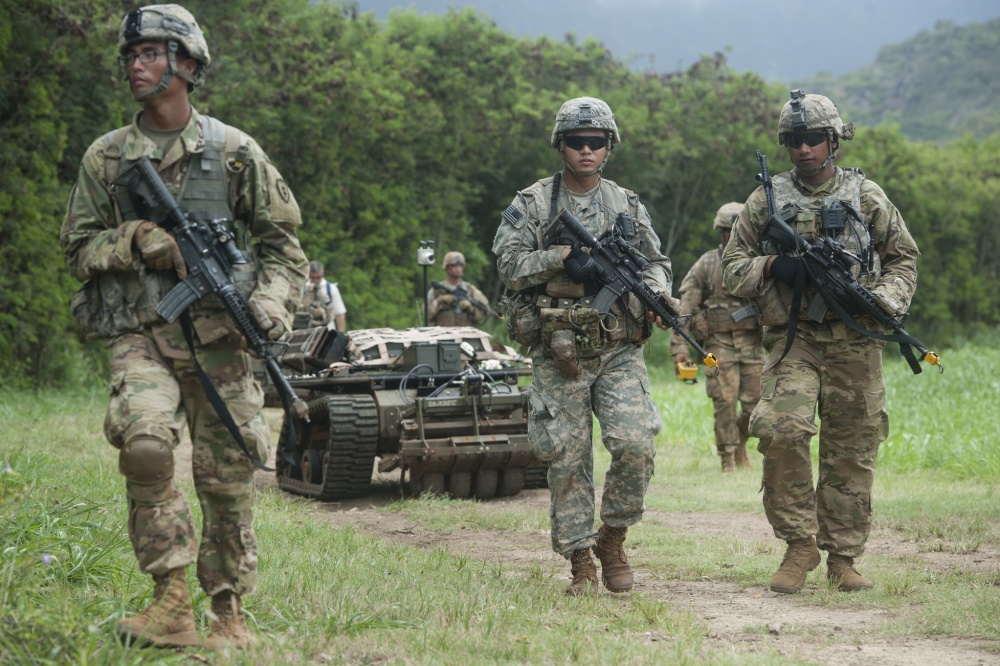This post is also available in:
 עברית (Hebrew)
עברית (Hebrew)
Groundbreaking military technologies were developed during 2019, from new power resources to human-machine teaming. Here are the top 10 of the leading ones developed by US army scientists to support future soldiers.
This is according to the CCDC Army Research Laboratory (ARL), an element of the U.S. Army Combat Capabilities Development Command. ARL discovers, innovates and transitions science and technology to ensure dominant strategic land power.
Number 10: Robots could be armed with artificial muscles made from plastic.
Artificial muscles could potentially augment robot performance. A research team expertizing in polymer science and chemical engineering helped to identify optimal material property values to achieve the desired artificial muscle performance targets, and helped develop and implement techniques to measure those material properties.
Number 9: Monitoring Soldier health and performance with biorecognition receptors
Army and academic researchers are looking at how to monitor Soldier health and performance in real-time, by developing unique biorecognition receptors. Once integrated into wearable biosensors, data can be selectively captured from a complex mixture of sources in theater, like blood, sweat or saliva. The Army of the future may use these wearable sensors to monitor environmental biothreats and health diagnostics, all with great benefits to the Soldier.
Number 8: A water-based, fire-proof battery
A new technology allows high-energy or high-power batteries to be put on the Soldier with no risk of the batteries catching on fire. These aqueous lithium-ion batteries replace the highly flammable electrolyte in lithium-ion batteries, using a nonflammable, water-based solvent–and also using a lithium salt that is not heat-sensitive, allowing for batteries to be stored and used at a much broader range of temperatures.
Number 7: Generating power on-demand with hydrogen
Army researchers are exploring potential applications for a structurally-stable, aluminum-based nanogalvonic alloy that reacts with any water-based liquid to produce on-demand hydrogen–generating power without a catalyst.
Number 6: 3-D printing ultra-strong steel
The technology that will revolutionize logistics will 3-D print ultra-strong metal parts, by adapting an alloy originally developed by the Air Force into powder form.
With a method called Powder Bed Fusion, a 3-D printer’s laser selectively melts the powder into a pattern. The printer then coats the build plate with additional layers of powder until the part is complete. The end result is a piece of steel that feels like it was forged traditionally, but has intricate design features that no mold could create, and is about 50% stronger than anything commercially available.
3-D printing (additive manufacturing) is going to have a huge impact on sustainment. Instead of worrying about carrying a whole truckload, or convoys loads of spares, as long as you have raw materials and a printer, you can potentially make anything you need. Researchers say this capability has the potential to replace parts of today’s tanks, or support future, state-of-the-art systems.
Number 5: Human interest detector
Army researchers have developed a human interest detector that can determine where people are looking and decode their brain activity, supplying better situational awareness on the battlefield and ultimately improve the ability of the Soldier to team with future AI agents.
By monitoring brainwaves, researchers track neural responses and assess what captures a Soldier’s attention among a myriad of stimuli in threat environments.
Number 4: AI to identify fuel-efficient materials
A new system of algorithmic bots could tackle the most complex challenges beyond human experimental capabilities. Building on amazing successes in artificial intelligence, a system called CRYSTAL was developed in attempt to explore new materials for long-lasting power for Soldiers. CRYSTAL relies on a collective of algorithmic bots that sift through hundreds of thousands of combinations and elements–a number so vast that it’s inaccessible through traditional experimentation.
The system is able to obey the laws of physics and chemistry–where existing machine learning approaches fail–and could identify the next generation of material breakthroughs that will equip Soldiers on the future battlefield.
Number 3: Robotic arrays for directional communication for urban environments
A new way to send directional radio signals in physically complex environments. The Army team designed small robotic platforms with compact, low frequency antennas and AI to create a system which adaptively self-organizes into a directional antenna array.
Although multi-directional radiation is not possible in low-frequency, this array is configured to emit an omni-directional radiation pattern, creating a directional link on-demand.
A robot with a compact, low-frequency antenna coordinates with other robotic teammates having passive unpowered antennas which help focus the electromagnetic field in a desired direction. This enables robust and targeted wireless communication at increased ranges through buildings and in challenging urban and subterranean environments.
Number 2: Self-healing material
A reversible cross-linking epoxy that is 3-D-printable and is self-healing at room temperature without any additional stimulus or healing agent. The unique chemistry of the material even enables it to be programmed to morph shape when stimulated with temperature.
Army researchers are exploring whether these materials could create reconfigurable Army platforms of the future that could morph shapes on-demand.
Number 1: Soldier-robot teams
New algorithms and capabilities that are unseen in industry enable autonomous agents such as robots to operate in unknown environments and scenarios, such as future battlefields.
These algorithms are creating the brain of robots, to equip them to interact with unforeseen objects and in unknown scenarios, ultimately preparing them to partner with Soldiers on the future battlefield, whatever it might look like.
This years’ coolest advances were picked up by the Lab’s chief scientist, Dr. Alexander Kott, as cited by eurekalert.org.


























